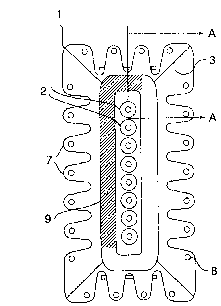Some of the information on this Web page has been provided by external sources. The Government of Canada is not responsible for the accuracy, reliability or currency of the information supplied by external sources. Users wishing to rely upon this information should consult directly with the source of the information. Content provided by external sources is not subject to official languages, privacy and accessibility requirements.
Any discrepancies in the text and image of the Claims and Abstract are due to differing posting times. Text of the Claims and Abstract are posted:
| (12) Patent Application: | (11) CA 2078460 |
|---|---|
| (54) English Title: | SCREENED RFI THROUGH-LET |
| (54) French Title: | DISPOSITIF DE BLINDAGE CONTRE LES SIGNAUX RADIOFREQUENCE |
| Status: | Deemed Abandoned and Beyond the Period of Reinstatement - Pending Response to Notice of Disregarded Communication |
| (51) International Patent Classification (IPC): |
|
|---|---|
| (72) Inventors : |
|
| (73) Owners : |
|
| (71) Applicants : |
|
| (74) Agent: | MARKS & CLERK |
| (74) Associate agent: | |
| (45) Issued: | |
| (22) Filed Date: | 1992-09-17 |
| (41) Open to Public Inspection: | 1993-03-28 |
| Examination requested: | 1998-11-03 |
| Availability of licence: | N/A |
| Dedicated to the Public: | N/A |
| (25) Language of filing: | English |
| Patent Cooperation Treaty (PCT): | No |
|---|
| (30) Application Priority Data: | ||||||
|---|---|---|---|---|---|---|
|
ABSTRACT
The present invention relates to an RFI through-let for screening
signals transmitted between different components, for instance
circuit boards, of which one component is arranged in a screened
space. The through-let includes signal-transmission through-let
capacitors which are mounted in a screen plate intended to be
positioned in a rectangular opening in the side-wall of the
screened space. According to the invention, the screen plate (3)
is comprised of a front part (3) which includes a rectangular,
generally flat plate having tongues or tabs (7) disposed along the
sides thereof and also having a central, rectangular hollow (9),
and a holding part (5) which is soldered firmly in the vicinity of
the hollow (9) of the front part (3). The holding part (5) includes
a flat plate whose long sides are bent to form guide flanges (11)
which extend perpendicularly downwards away from the front part
(3), along a first line (A) corresponding to the long sides of the
opening (6), and along a second line (B) downwardly of the first
line are further bent inwardly towards one another. Parts (12)
punched-out along the first line (A) cause shoulders (13) to be
formed in the second bending operation, these shoulders projecting
upwards and outwards towards the front part and are intended to
grip-in behind the side-wall (4) of the space when fitting the
screen plate (1) and therewith hold the screen plate firmly in the
opening.
Note: Claims are shown in the official language in which they were submitted.
Note: Descriptions are shown in the official language in which they were submitted.

2024-08-01:As part of the Next Generation Patents (NGP) transition, the Canadian Patents Database (CPD) now contains a more detailed Event History, which replicates the Event Log of our new back-office solution.
Please note that "Inactive:" events refers to events no longer in use in our new back-office solution.
For a clearer understanding of the status of the application/patent presented on this page, the site Disclaimer , as well as the definitions for Patent , Event History , Maintenance Fee and Payment History should be consulted.
| Description | Date |
|---|---|
| Inactive: IPC from PCS | 2022-09-10 |
| Inactive: IPC deactivated | 2011-07-27 |
| Inactive: IPC expired | 2011-01-01 |
| Inactive: IPC from MCD | 2006-03-11 |
| Inactive: First IPC derived | 2006-03-11 |
| Inactive: IPC from MCD | 2006-03-11 |
| Time Limit for Reversal Expired | 2002-09-17 |
| Application Not Reinstated by Deadline | 2002-09-17 |
| Deemed Abandoned - Failure to Respond to Maintenance Fee Notice | 2001-09-17 |
| Letter Sent | 1998-12-07 |
| Inactive: Status info is complete as of Log entry date | 1998-12-07 |
| Inactive: Application prosecuted on TS as of Log entry date | 1998-12-07 |
| Request for Examination Requirements Determined Compliant | 1998-11-03 |
| All Requirements for Examination Determined Compliant | 1998-11-03 |
| Application Published (Open to Public Inspection) | 1993-03-28 |
| Abandonment Date | Reason | Reinstatement Date |
|---|---|---|
| 2001-09-17 |
The last payment was received on 2000-09-12
Note : If the full payment has not been received on or before the date indicated, a further fee may be required which may be one of the following
Please refer to the CIPO Patent Fees web page to see all current fee amounts.
| Fee Type | Anniversary Year | Due Date | Paid Date |
|---|---|---|---|
| MF (application, 5th anniv.) - standard | 05 | 1997-09-17 | 1997-08-05 |
| MF (application, 6th anniv.) - standard | 06 | 1998-09-17 | 1998-09-01 |
| Request for examination - standard | 1998-11-03 | ||
| MF (application, 7th anniv.) - standard | 07 | 1999-09-17 | 1999-09-03 |
| MF (application, 8th anniv.) - standard | 08 | 2000-09-18 | 2000-09-12 |
Note: Records showing the ownership history in alphabetical order.
| Current Owners on Record |
|---|
| TELEFONAKTIEBOLAGET LM ERICSSON |
| Past Owners on Record |
|---|
| ERIK LENNART OVANFORS |
| KJELL OLOV HANSSON |